Mediterranean - River Plate
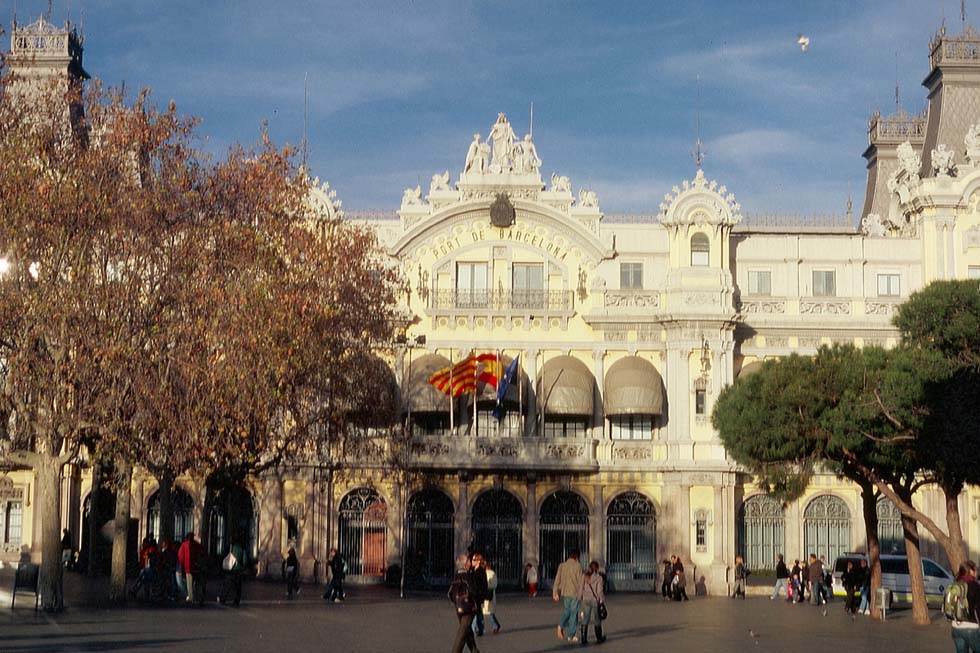
The old port of Barcelona (WS)
Italy
Based on migrant traffic, Italy kept always a strong position on the River Plate route. Italy's first ocean-going company was (according to N.R.P. Bonsor) the Compagnia Transatlantica, founded in 1852 by Raffaele Rubattino and partners. With the "Vittorio Emanuele" and "Conte di Cavour" they opened Genoa - Rio de Janeiro services in 1856. Captain G. Lavarello commissioned in 1864 the "Buenos Aires" of only 377 tons and started a South America service, from 1883 running under the label La Veloce. I & V. Florio opened Atlantic services in 1879. In 1881 Florio and Rubattino founded the Navigazione Generale Italiana (NGI) . The company entered the South America trade in 1885. They took over the fleet of Raggio & Co. , which had been built up in 1881 for the Genoa - River Plate route. NGI swallowed also Rocco Piaggio & Figli, which provided a Genoa - Valparaiso service. Towards the end of the 19th century, NGI was listed with a Genoa - Buenos Aires route, while La Veloce provided Genoa - Pernambuco - Santos and Genoa - Buenos Aires services, specially for emigrants. In 1894 Ligure Romana was founded, renamed Ligure Brasiliana in 1897. In 1899 'Italia' S.A. di Navigazione was established under participation of Hapag. Their Genoa - Buenos Aires services, were initiated with ships chartered from Hapag. In 1906 the Lloyd Sabaudo was founded for South America services. The Lloyd Italiano, separated in 1905 form NGI, added in 1909 River Plate services to its North Atlantic route. The Sicula Americana, then Sicula Oceanica, founded in 1906, was another company to enter the South America traffic. During WWI this company and Lloyd Italiano got integrated into the 'Transoceanica'. In 1913 the Ligure Brasiliana was for sale and Hapag acquired the company. Their little steamers "Cavour" and "Garibaldi" continued South America services, but Hapag commissioned immediately new ships for its successor Transatlantica Italiana, which entered North Atlantic services in 1915.
Another matter was the South America traffic departing from Trieste, which was the main port of the Habsburg Empire of Austria. The Unione Austriaca di Navigazione, founded in 1903 by the Cosulich brothers, Hapag and Norddeutscher Lloyd, was awarded a mail contract for the Trieste - River Plate route in 1911. Kludas listed as their 'largest' ship on the South Atlantic route the 5,526-ton "Argentina", built in 1907. Bradshaw's timetable of 1914 mentioned an Adria Line Fiume (Rijeka) - Trieste - Rio - Santos.
Italy entered World War I in 1915. With the end of the war, the Habsburg Empire was dissolved, followed by a re-organization of the residing shipping companies. Unione Austriaca became the Cosulich Line. NGI integraed La Veloce and Sicula Oceanica, amalgamated with Lloyd Italiano. The latter was hit in 1927 by the loss of the 9,200-ton "Principesssa Mafalda" off the coast of Brazil, with more than 300 casualties. Lloyd Sabando transferred in 1924 their "Principessa Giovanna" and "Principessa Maria" (8,917 gt) from Australian to South American itineraries. Larger were the "Conte Verde" and "Conte Rosso" (1923 / 18,700 gt). In 1928 NGI relocated the "Giulio Cesare" (1922/21,848 gt) and "Duilio" (24,281 gt) from the North Atlantic to the River Plate route. The NGI operated in partnership with Cosulich and Lloyd Sabaudo from 1932 as 'Italia" Flotte Riunite. The participants preserved their label and in the '30s the 19,500-ton motor ships "Neptunia" and "Oceania" of the Cosulich Line were among the most modern of their kind on the South Atlantic. After the prestige liners "Rex" and "Conte di Savoia" of the 'Italia' were placed in service on the North Atlantic route, in 1933 the 25,661-ton "Conte Grande" and in 1937 the "Roma" (32,582 gt, 24 knots) and the diesel-powered "Augustus" (32,650 ts, 19 knots) were repositioned on the River Plate route. Of course there were smaller vessels, too, e.g. the "Sardegna" (11,500 gt, ex "Sierra Ventana" of Norddeutscher Lloyd). From 1937 'Italia' was responsible exclusively for the North and South Atlantic routes, until World War II stopped every Italian transoceanic service in 1940.
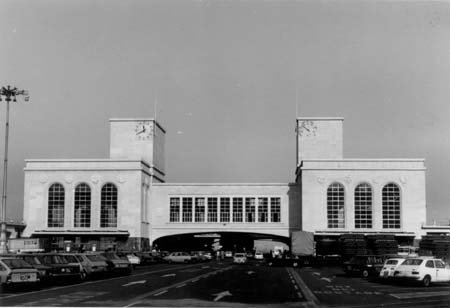 Ocean terminal Naples in the 70s (WS)
Ocean terminal Naples in the 70s (WS)
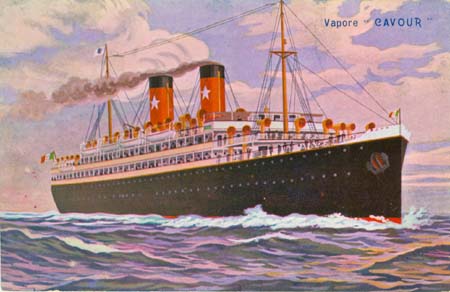
"Cavour", ad Transatlantica Italiana to South America (coll. WS)
|
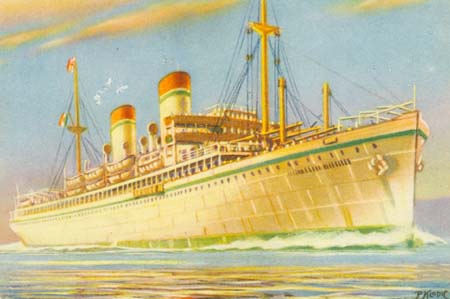
Principessa class of 'Italia' (old card, coll. WS)
|
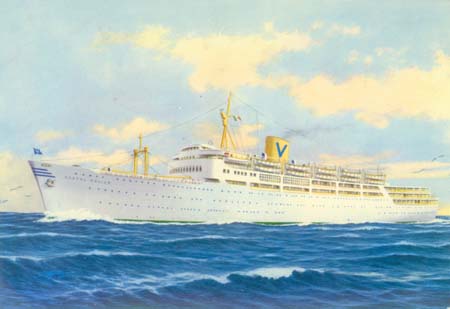
"Castel Felice", Sitmar Line (old card, coll. WS)
|
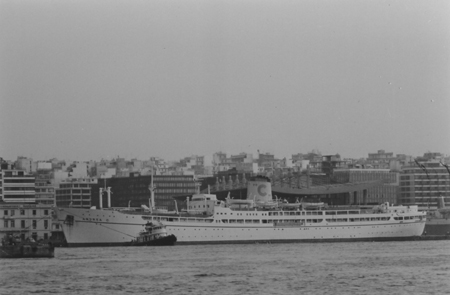
"Andrea C", Linea 'C', Piraeus 1980 (WS)
|
With World War II Italy had lost most of its fleet. First initiator to resume South America services from Genoa was Home Lines of Greek entrepreneur Eugen Eugenides. He had purchased the Norwegian 11,000-ton "Bergensfjord" and employed her from 1946 as "Argentina" on the Genoa - Buenos Aires route, with Cosulich as operator. From 1948 the "Brasil" (1905/11,182 gt, ex "Virginian", "Drottningholm") and then the "Italia" (1928/21,600 gt, ex "Kungsholm" of Svenska Amerika Linjen) entered the South America service, while the "Argentina" changed in 1949 to the Caribbean and the "Brasil" in 1959 to the North Atlantic as "Homeland". In the '60s Home Lines confined its activities to cruises, mainly from New York to Latin American destinations. Also the Sitmar Line of the Vlasov group appeared in the 50s on the River Plate route with the steamer "Castel Felice" (12,149 gt, built in 1940 as "Kenya" for the British India Line), in 1954 relocated to the Australia route. A more modest service to Argentina was established by Cogedar Line with the motor ship "Genova" (a rebuilt freighter), for emigrants destined to work in Fireland, abandoned in 1954.
After WWII the 'Italia' Societa di Navigazione or Italian Line had been reconstituted, managed by the government. In early 1947 the "San Giorgio" (1923/8,955 gt, ex "Principessa Giovanna" of Lloyd Sabaudo) resumed Buenos Aires services. Passenger-cargo ships of the Navigatori class reopened the Valparaiso route via Panama. In 1949 the rebuilt "Conte Grande" (1928/23,841 gt) and "Conte Biancamano" (1925/23,562 gt) were introduced on the express line Genoa - Buenos Aires. The government had started a great shipbuilding programme. From 1951 the new 27,000-ton motor ships "Giulio Cesare" and "Augustus", typical for their flat funnel, dominated the South Atlantic route. Their interiors were styled by Gio Ponti and Nino Zoncada resp. Nordio and Gustavo Pulitzer (according to P. Kohler). Only after the loss of the "Andrea Doria" in 1956, they were temporarily relocated to replace her on the North Atlantic. The Valparaiso route via Panama was served by the 13,000-ton motor ships "Donizetti", "Verdi" and "Rossini" of 1951 (ex "Australia", "Neptunia" and "Oceania" of Lloyd Triestino). The 27,905-ton "Guglielmo Marconi", a turbine-steamer built in 1963 for Australia services of the Lloyd Triestino, undertook in January 1976 her first voyage Naples - Buenos Aires for the 'Italia'. Nevertheless already in 1974 financial losses and labour unions' actions forced the government-owned holding Finmare to decide for a closedown of transoceanic services. While the "Giulio Cesare" was scrapped, the "Augustus" continued services until 1976 (in 1999, after half a dozen changes in ownership, she became the hotel ship "Philippines", laid up at Manila). The "Guglielmo Marconi" was laid up in 1977, cruised in 1978 for Italia Crociere International in the Caribbean and was taken over in 1984 by Costa as the cruise ship "Costa Riviera".
The roots of the Costa Line are going back to the year 1924. The Costa brothers entered passenger business in 1948. In the '60s that Linea "C" maintained regular Genoa - Buenos Aires services with the "Federico C" (1958/20,416 gt, registered for Lloyd Tirreno), then replaced by the beautiful new motor ship "Eugenio C" (1966/30,567 gt), the "Enrico C" (1951/15,719 gt ex "Provence" of SGTM) and the minor "Andrea C" (1942/8,604 gt, ex "Ocean Virtue"). Towards the end of the '70s, the ABC Shipping Guide listed Costa Line with the "Eugenio C", "Enrico C", "Flavia" and "Angelina" on the Buenos Aires route. Other vessels were employed on cruises and made Costa Crociere one of the leaders in that business - see chapter Cruises.
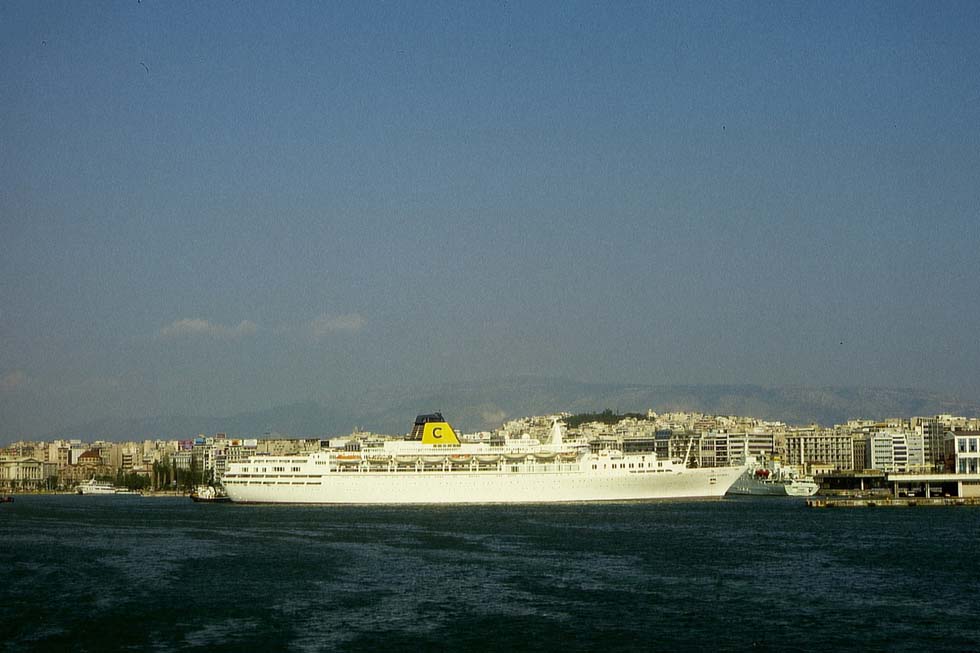
"Costa Riviera" ex "Guglielmo Marconi", Piraeus 1995 (WS)
Spain
Long after the Marques de Comillas had started steamer services in the Caribbean, the Marques de Campo inaugurated a service between Antwerp and Brazil. He had bought the "Rakakia" from the Royal Mail Steam Packet Co. and employed her from 1872 on that route as "Ebro". In 1884 the ship was sold to the Compania Trasatlantica, which added the Buenos Aires route to their Caribbean services in 1886.
A company of Cadiz, well established in the America trade, was Pinillos, Izyquierdo y Cia. Historian L. Dunn described their twin-funnel "Manila" class of 1895, the 5,600-ton "Barcelona" and "Cadiz" of 1908 and the 8,182-ton "Infanta Isabel", steamers of pleasant appearance with a black hull, while superstructure and a black funnel with the red/white trade mark. In 1916 the company suffered a severe loss when the new flagship "Principe de Asturias", bound for Buenos Aires, ran aground and 400 people died. After a second accident the company went bankrupt. Around 1925 the Cia. Transoceanica de Navegacion bought the ships, but sold them soon after.
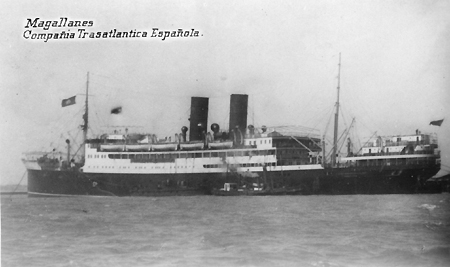
"Magallanes", Compania Trasatlantica (old card, coll. WS)
|
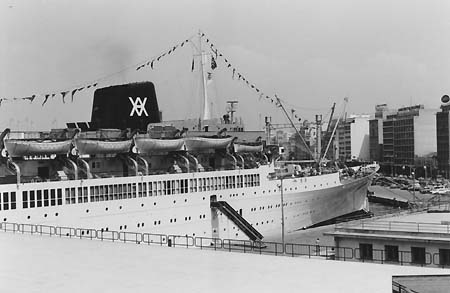
"Cabo San Vicente", Ybarra y Cia., Piraeus 1973 (WS)
|
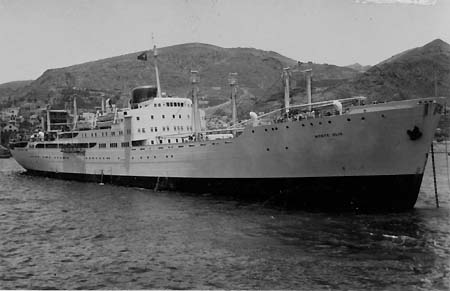
"Monte Ulia" of 1952, Naviera Aznar (coll. WS)
|
|
Facing the competition by Pinillos, the market leader Cia Trasatlantica had to renew its antiquated fleet. In 1913 the "Reina Victoria-Eugenia" (10,136 gt) and "Infanta Isabel de Bourbon" (10,348 gt) were delivered. They showed classic outlines with a black hull, white superstructure and a black upright funnel. Apart from a short interlude on the New York route during WWI, they were employed on the Barcelona - Buenos Aires route. In accordance with the end of the monarchy in 1931, the ships had to be renamed "Argentina" and "Uruguay", from 1932 they lay idle at Barcelona, during the civil war the "Uruguay" was a prison afloat where victims were sentenced and in 1939 the ships were sunk by an air attack. During the 30s the largest Spanish ships on the South Atlantic route had been the 11,868-ton "Cabo San Agustin" and "Cabo Santo Tome" of Ybarra.
Franco saved Spain from becoming involved into World War II, but his repressive regime hampered economy. In the '60s the Cia. Trasatlantica maintained Caribbean services, but the River Plate route had disappeared. Curt Frick mentioned (in 'Passagierschiffe', edited in 1967) only the Ybarra y Cia. and Naviera Aznar with passenger-cargo vessels on the South America route.
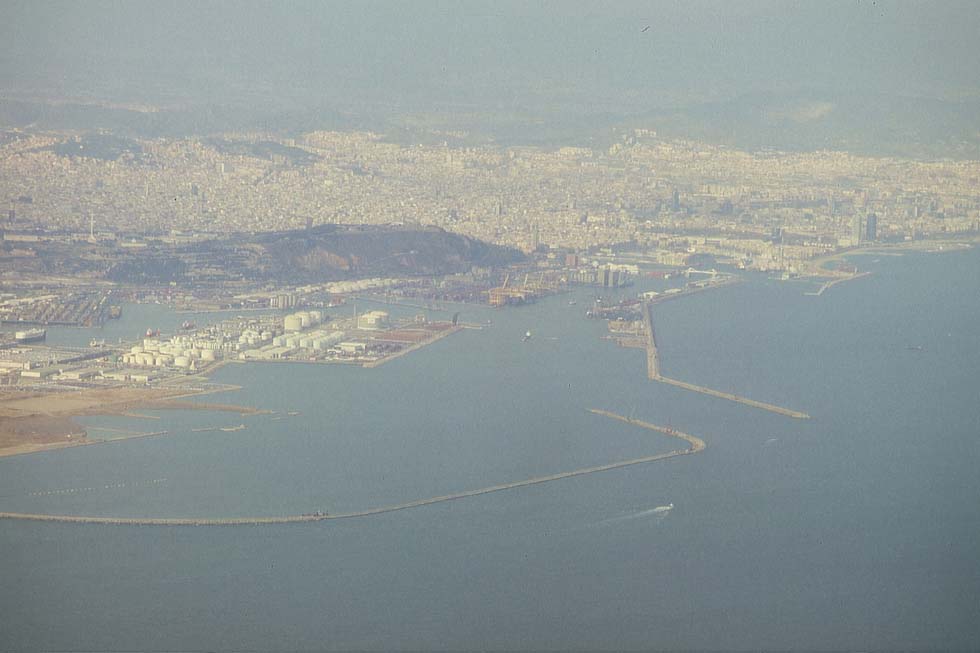
Barcelona (WS)
|